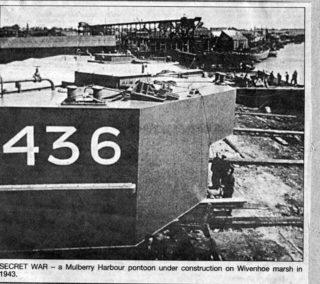The building of parts of the WWII Mulberry Harbour in Wivenhoe
Built for the D-Day Normandy landings in 1944
John Stewart and the late Bill Ellis
In 1944, sections of the Mulberry Harbour pontoons were constructed on the marshes next to Wivenhoe Shipyard, now the Port estate.
Dorman Long and Co. Ltd and ‘Project Shark’
Started in 1943, Dorman Long and Co. took over an area of marshland just upstream from the Wivenhoe Shipyard. There the company built a number of large and small floating steel caissons for use during the forthcoming invasion of Europe. The caissons were intended to be brought into service to seal lock and dock entrances destroyed or damaged by demolition or other enemy action after being towed across the Channel.
An area of the saltings of about 3 acres was involved. 12 cranes, each of 30 ton lift, together with railway lines, concrete pads and roadways were built on the marshland to enable the units to be built on a production line basis. Initially it was planned for 151 large and 151 small units to be constructed, however only about one third of the number were actually made.
10,000 tons of steel, and some 3,000 tons of timber, was allocated for the original scheme. The dimensions of individual units, which could be bolted together to form larger caissons were: height 30 feet; width 7 feet and length 40 feet.
For more about the building of these Mulberry Harbour sections – click here
Comments
Chris Whaley: My grandad worked on them & said they where built like a honeycomb inside. To make getting out easy they followed a length of string they had unrollled as they went in.







Comments about this page
The Mulberry harbour element shown in the photo is a Buffer Pontoon. This was a type of artificial beach that attached to a Spud Pier Head so that LCTs and LSTs could beach and so unload through their bow ramps. Two buffer pontoons were built at Wivenhoe numbers 436 (as shown in the photo) and 437. Others were built at Conway and Dartford.
Thanks for this clarification Chris. Appreciated.
Peter Hill, Chairman, Wivenhoe History Group
Add a comment about this page